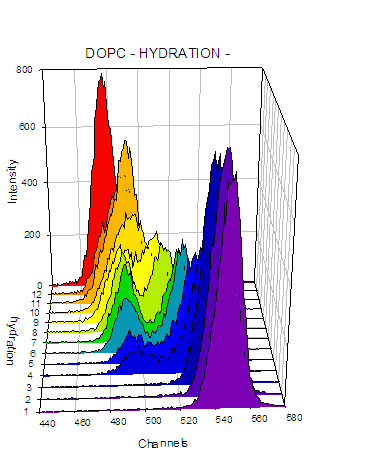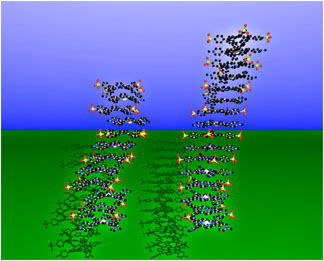EDXD-GROUP |
|
ENERGY DISPERSIVE X-RAY DIFFRACTION
|
|
ENERGY DISPERSIVE X-RAY REFLECTOMETRY
|
CURRENT RESEARCH
The research activities of the Group are focussed in the field of the structural analysis of biomolecular systems (lipids, DNA-lipids complexes) and liquids, amorphous, ionic liquids, crystalline compounds.
The treatment of the post-processing of experimental X-ray data (calculation of structure functions, refinement of models and study of kinetics) is performed using specific programs, purposely written in Fortran by Professore Ruggero Caminiti and Dr. Lorenzo Gontrani.
The current research directions are:
1. Cationic Liposome-DNA Complexes for Gene Delivery:
a) Elucidating the mechanism of formation of lipoplexes.
b) Elucidating the mechanism of internalization of lipoplexes within the cell.
c) Clarifying the role played by surface charge density of liposomes in modulating the transfection efficiency of lamellar lipoplexes.
d) Role of divalent biological counterions on the DNA condensation inside oriented lipoplexes.
e) Lipoplexes functionalization. |
|
 |
 |
|
2. Hydration Effect on the Structure of Oriented Multibilayers.
The group explores the properties of membranes by means of E.D.X.D. applying RH (relative humidity) techniques.
Recently, we have constructed a new hydration cell that allows to fully hydrate aligned lipid multibilayers as well as to study lipid hydration by using in situ time-resolved energy dispersive X-ray diffraction (EDXD) .
The cell has been used to investigate the evolution of the lamellar d-spacing of dioleoylphosphocoline oriented membranes as a function of both relative humidity (RH) and time.
The extreme sensitivity of d to RH was shown and two hydration regimes were detected .
|
3. Structural Analysis of Liquids.
Structure and dynamics of ionic liquids.
Study of solute-solvent interactions in organic molecules solutions.
Structure of aqueous and non-aqueous solutions.
|
|
 |
 |
|
4. Amorphous Compounds
|
| 5. Phase Transitions
|
|
 |
|
|
6. Thin Films- Reflectivity
The X-ray reflectometry technique (XRR) is a powerful method for investigating monolithic and multilayered film structures.
XRR studies are highly sensitive to electron density gradients irrespective of the crystalline nature of the system investigated.
It is also one of the few methods that, with great accuracy, allow one to extract information not only on the free surface and the interface(s), but also to determine the mass density, the thickness and the roughness of thin layers along the direction normal to the specimen surface.
When an X-ray reflectivity measurement is performed, the advantages of the ED mode are remarkable.
In fact, the experimental geometry remains unchanged during data collection, which is a fundamental advantage for in situ time resolved studies.
|
7. Research activities: (1)
Bioactive glass-ceramic implant coatings for regenerative nanomedicine
The research is aimed to realize bioactive glass-ceramic coatings doped with various ions for application in regenerative nanomedicine as bioresorbable and bioactive third generation biomaterials. The efforts in biomaterials science field are on the way of transition from the inert materials to the tissue-integrated ones, and finally, passing to the materials, which are supposed to be substituted by the newly formed tissue. Glass-ceramics result to be suitable for this scope. Porous glass-ceramic matrix structures, containing various homogeneously dispersed micro- and nano-phases, can be prepared. The quality and quantity of the additional phases could be controlled during the sol-gel production phase. The choice of doping ions is governed, first of all, by their role in the human body, exploiting, along with the various literature sources, also the long-lasting experience in thermal mud-bath treatments. Following this way, biomaterial can be recognized by biological system mimicking its composition. The actions of the appropriate ions and their controlled release should induce the cells of different specialization and their genes to adhere to the artificial biomimetic composites. |
|
|
 |
|
8. Research activities: (2)
In situ time-resolved Energy Dispersive X-Ray Diffraction studies of transformation/crystallization processes of biogenic calcium phosphate materials for bone tissue engineering applications
(A) Calcium phosphate precursor phases in biomineralization process
The nature of precursor phase during the biomineralization process of bones and teeth is still controversial, several phases being hypothesized. They include octacalcium phosphate, amorphous calcium phosphate and dicalcium phosphate dehydrate. It is believed that these precursor phases may participate in biological mineralization forming final calcium deficient carbonate substituted hydroxyapatite phase. However, the biomineralization mechanism still remains unclear, and the functional role of precursor phases is to be clarified. The aim of this research is the in situ investigation of the structural transformations happening to calcium phosphate precursor phases of biological apatite under physiological conditions.
The crystallization dynamics of biogenic calcium phosphate materials in the presence of additive molecules is followed as well. The co-operative effect of various calcium phosphate molecule species combination in Simulated Body Fluid, leading to the hydroxyapatite formation, is investigated. Energy Dispersive X-Ray Diffraction technique is applied for in situ monitoring of the processes taking place in the systems in real time. By means of this approach, allowing to control the HA crystallization, calcium phosphate based biomaterials can be modified for implant-use in hard tissue engineering. |
9. (B) Calcium phosphate bone cements
Calcium phosphate based materials are widely used in various biomedical applications, since a calcium phosphate belonging to the group of biocompatible and bioactive ceramics -hydroxyapatite- is the main constituent of the mineral component of bone and teeth. In recent years, considerable efforts have been focused on the development of calcium phosphate cements (CPC), used as injectable bone substitutes in orthopaedic and dental medicine due to their favourable tissue responses.
In this research, hardening process of various cement formulations is in situ monitored by the Energy Dispersive X-Ray Diffraction technique, a suitable tool for real -time studies. Together with phase transformations, amorphous-into-crystalline conversion (i.e. the primary and secondary crystallization processes) is followed, and the characteristic crystallization times for phases of interest are deduced. The role of biopolymers on the phase development and kinetics of CPC hardening is investigated. |
|
 |
|











